


Delhi is the capital city of India and is regarded as the heart of the nation. The city is popular for its enriched culture and heritage. The city hosts some famous historical monuments and is developing with the passing of time.
The influence of religious diversity can be seen in the city along with the cultural impact of the Mughal, the ancient Indian and the British. There are many beautiful gardens in the city, away from pollution and busy city life that provide opportunities to walk leisurely in the midst of greenery.
The average maximum daytime temperature in Delhi in July is a hot 35°C (95°F) with extreme heat & humidity. The average night-time temperature is usually a warm 25°C (77°F). There are usually 7 hours of bright sunshine each day, which represents 56% of the 13 hours of daylight.
Expected rainfall during the month of July is 183mm (7.2 inches).
It is advised to carry Summer wear (cotton clothing).
Some of the major attractions in Delhi are:
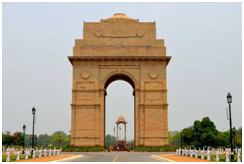 India
Gate is a is 42 m high war memorial located on Rajpath at the centre of
New Delhi. It is an archway in the middle of a crossroad and commemorates the 70,000
Indian soldiers who lost their lives fighting for the British Army during the World
War I. The memorial bears the names of more than 13,516 British and Indian soldiers
killed in the Northwestern Frontier in the Afghan war of 1919.
India
Gate is a is 42 m high war memorial located on Rajpath at the centre of
New Delhi. It is an archway in the middle of a crossroad and commemorates the 70,000
Indian soldiers who lost their lives fighting for the British Army during the World
War I. The memorial bears the names of more than 13,516 British and Indian soldiers
killed in the Northwestern Frontier in the Afghan war of 1919.
 Rashtrapati Bhavan is the official home of the President of India. It is
located at the Western end of Rajpath in New Delhi, India. The four floor 340-room
main building with a floor area of 200,000 square feet (19,000 m2) was built using
1 billion bricks and 3,000,000 cu ft (85,000 m3) of stone with little steel. It
has the president's official residence, halls, guest rooms and offices. Besides
the main building, the 320 acre Presidential Estate includes huge presidential gardens
Mughal Gardens, large open spaces, residences of bodyguards and staff, stables,
other offices and utilities within its perimeter walls. In terms of area, it is
one of the largest residences of a head of state in the world.
Rashtrapati Bhavan is the official home of the President of India. It is
located at the Western end of Rajpath in New Delhi, India. The four floor 340-room
main building with a floor area of 200,000 square feet (19,000 m2) was built using
1 billion bricks and 3,000,000 cu ft (85,000 m3) of stone with little steel. It
has the president's official residence, halls, guest rooms and offices. Besides
the main building, the 320 acre Presidential Estate includes huge presidential gardens
Mughal Gardens, large open spaces, residences of bodyguards and staff, stables,
other offices and utilities within its perimeter walls. In terms of area, it is
one of the largest residences of a head of state in the world.
 Qutab
Minar is a soaring, 73 m-high tower of victory, built in 1193 by Qutab-ud-din
Aibak immediately after the defeat of Delhi's last Hindu kingdom. The tower has
five distinct storeys, each marked by a projecting balcony and tapers from a 15
m diameter at the base to just 2.5 m at the top. The first three storeys are made
of red sandstone; the fourth and fifth storeys are of marble and sandstone. At the
foot of the tower is the Quwwat-ul-Islam Mosque, the first mosque to be built in
India.
Qutab
Minar is a soaring, 73 m-high tower of victory, built in 1193 by Qutab-ud-din
Aibak immediately after the defeat of Delhi's last Hindu kingdom. The tower has
five distinct storeys, each marked by a projecting balcony and tapers from a 15
m diameter at the base to just 2.5 m at the top. The first three storeys are made
of red sandstone; the fourth and fifth storeys are of marble and sandstone. At the
foot of the tower is the Quwwat-ul-Islam Mosque, the first mosque to be built in
India.
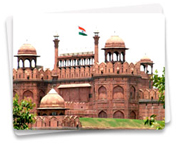 Red
Fort - Red sandstone walls rise 33-m above the clamour of Old Delhi as a
reminder of the magnificent power and pomp of the Mughal emperors. The walls, built
in 1638, were designed to keep out invaders. The main gate, Lahore Gate, is one
of the emotional and symbolic focal points of the modern Indian nation and attracts
a major crowd on each Independence Day. The vaulted arcade of Chatta Chowk, a bazaar
selling tourist trinkets, leads into the huge fort compound. Inside is a veritable
treasure trove of buildings. An evening sound and light show re-creates events in
India's history connected with the fort. Red Fort is closed on Mondays of every
week.
Red
Fort - Red sandstone walls rise 33-m above the clamour of Old Delhi as a
reminder of the magnificent power and pomp of the Mughal emperors. The walls, built
in 1638, were designed to keep out invaders. The main gate, Lahore Gate, is one
of the emotional and symbolic focal points of the modern Indian nation and attracts
a major crowd on each Independence Day. The vaulted arcade of Chatta Chowk, a bazaar
selling tourist trinkets, leads into the huge fort compound. Inside is a veritable
treasure trove of buildings. An evening sound and light show re-creates events in
India's history connected with the fort. Red Fort is closed on Mondays of every
week.
 Jantar
Mantar was constructed in 1724. Maharaja Jai Singh of Jaipur who built this
observatory and went on to build other observatories in Ujjain, Varanasi and Mathura.
Jai Singh had found the existing astronomical instruments too small to take correct
measurements and so he built these larger and more accurate instruments. The instruments
at Jantar Mantar are fascinating for their ingenuity
Jantar
Mantar was constructed in 1724. Maharaja Jai Singh of Jaipur who built this
observatory and went on to build other observatories in Ujjain, Varanasi and Mathura.
Jai Singh had found the existing astronomical instruments too small to take correct
measurements and so he built these larger and more accurate instruments. The instruments
at Jantar Mantar are fascinating for their ingenuity
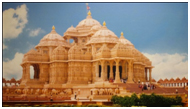 Akshardham
temple in New Delhi epitomizes 10,000 years of Indian culture in all its
breathtaking grandeur, beauty, wisdom an d bliss. It brilliantly showcases the essence
of India’s ancient architecture, traditions and timeless spiritual messages. The
Akshardham experience is an enlightening journey through India’s glorious art, values
and contributions for the progress, happiness and harmony of mankind. The temple
is closed on Mondays of every week.
Akshardham
temple in New Delhi epitomizes 10,000 years of Indian culture in all its
breathtaking grandeur, beauty, wisdom an d bliss. It brilliantly showcases the essence
of India’s ancient architecture, traditions and timeless spiritual messages. The
Akshardham experience is an enlightening journey through India’s glorious art, values
and contributions for the progress, happiness and harmony of mankind. The temple
is closed on Mondays of every week.
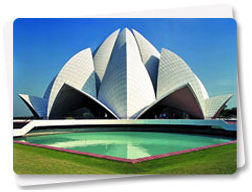 Lotus
temple is built in the shape of a lotus flower and is the last of seven
Major Bahai's temples built around the world. Completed in1986 it is set among the
lush green landscaped gardens. The structure is made up of pure white marble. The
architect Furiburz Sabha chose the lotus as the symbol common to Hinduism, Buddhism,
Jainism and Islam. Adherents of any faith are free to visit the temple and pray
or meditate. Around the blooming petals there are nine pools of water, which light
up, in natural light. It looks spectacular at dusk when it is flood lit.
Lotus
temple is built in the shape of a lotus flower and is the last of seven
Major Bahai's temples built around the world. Completed in1986 it is set among the
lush green landscaped gardens. The structure is made up of pure white marble. The
architect Furiburz Sabha chose the lotus as the symbol common to Hinduism, Buddhism,
Jainism and Islam. Adherents of any faith are free to visit the temple and pray
or meditate. Around the blooming petals there are nine pools of water, which light
up, in natural light. It looks spectacular at dusk when it is flood lit.
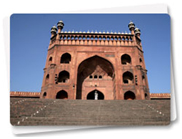 Jama
masjid is located in the walled city or Old Delhi, and is the largest in
India with a courtyard capable of holding 25,000 devotees at a time. Construction
began in 1644 and ended up being the final architectural extravagance of Shah Jahan,
the Mughal emperor who also built the Taj Mahal and the Red Fort. The highly decorative
mosque has three great gates, four towers and two 40 m-high minarets constructed
of strips of red sandstone and white marble.
Jama
masjid is located in the walled city or Old Delhi, and is the largest in
India with a courtyard capable of holding 25,000 devotees at a time. Construction
began in 1644 and ended up being the final architectural extravagance of Shah Jahan,
the Mughal emperor who also built the Taj Mahal and the Red Fort. The highly decorative
mosque has three great gates, four towers and two 40 m-high minarets constructed
of strips of red sandstone and white marble.
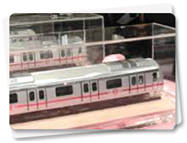 Metro
Museum at Patel Chowk Metro station is the only such installation worldwide
in an operational Metro station. DMRC has a rich and varied history because of the
nature of the project that is India's largest urban intervention in the transportation
sector since Independence. Built in one of the most congested cities in the world,
the Delhi Metro used cutting edge technology from around the world including Germany,
France, Japan, Korea, etc. to create a system that is one of the most advanced in
the world The Museum has an extensive section on the construction of the Metro and
the problems encountered during the process, including the story behind the construction
of technological marvels such as the Chawri Bazaar Metro station, which is the second
deepest Metro station in the world, India's first extra-dosed bridge. A model of
Tunnel Boring Machine (TBM), a "tooth" taken from a TBM, soil samples collected
from around the city.
Metro
Museum at Patel Chowk Metro station is the only such installation worldwide
in an operational Metro station. DMRC has a rich and varied history because of the
nature of the project that is India's largest urban intervention in the transportation
sector since Independence. Built in one of the most congested cities in the world,
the Delhi Metro used cutting edge technology from around the world including Germany,
France, Japan, Korea, etc. to create a system that is one of the most advanced in
the world The Museum has an extensive section on the construction of the Metro and
the problems encountered during the process, including the story behind the construction
of technological marvels such as the Chawri Bazaar Metro station, which is the second
deepest Metro station in the world, India's first extra-dosed bridge. A model of
Tunnel Boring Machine (TBM), a "tooth" taken from a TBM, soil samples collected
from around the city.
Dilli Haat INA, Aurbindo Marg, New Delhi is not just a market place; it has
been visualized as a showpiece of traditional Indian culture- a forum where rural
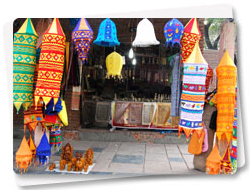 life and folk art are brought closer to an urban clientele. The 6 acres of land
on which this sprawling complex is situated was salvaged as part of a reclamation
project and transformed into a magnificent dream plaza. Extensive foundation work,
small thatched roof cottages and kiosks with a village atmosphere have made the
place into an attractive multiple center. The complex is not only artistic, but
also recreational in nature where the entire family can have a good time.
life and folk art are brought closer to an urban clientele. The 6 acres of land
on which this sprawling complex is situated was salvaged as part of a reclamation
project and transformed into a magnificent dream plaza. Extensive foundation work,
small thatched roof cottages and kiosks with a village atmosphere have made the
place into an attractive multiple center. The complex is not only artistic, but
also recreational in nature where the entire family can have a good time.
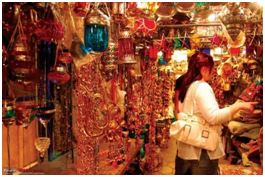 Janpath,
the most popular place for street shopping is situated opposite the famous Connaught
Place, in New Delhi. Other than the fixed small shops and local stalls, there are
also local cloth/Mojari or Jutti (a Punjabi or Rajisthani footwear)/purse and other
handicraft artisans sitting between the lanes of fixed shops with amazing traditional
embroidered merchandise. The Tibetan Market, near Hotel Imperial, is a storehouse
of silver jewellery, thangkhas and brassware curios and Tibetan artifacts. Timing:
Monday- Saturday, 10.30 am to 7.30 pm
Janpath,
the most popular place for street shopping is situated opposite the famous Connaught
Place, in New Delhi. Other than the fixed small shops and local stalls, there are
also local cloth/Mojari or Jutti (a Punjabi or Rajisthani footwear)/purse and other
handicraft artisans sitting between the lanes of fixed shops with amazing traditional
embroidered merchandise. The Tibetan Market, near Hotel Imperial, is a storehouse
of silver jewellery, thangkhas and brassware curios and Tibetan artifacts. Timing:
Monday- Saturday, 10.30 am to 7.30 pm
 South Extension market located in South Delhi on the arterial Ring Road has
two parts –South Extension I and South Extension II. Both markets face each other.
Known for branded apparel, exquisite jewellery, gorgeous selection of bridal wear
garments, fancy footwear and trendy accessories and south Indian silks. Many interesting
shops are tucked away in the side and back lanes also. There are many street vendors
and street snack corners selling delicious mouth watering must have local fast food.
It is one of the best places to go shopping in Delhi and is closed on Monday of
every week.
South Extension market located in South Delhi on the arterial Ring Road has
two parts –South Extension I and South Extension II. Both markets face each other.
Known for branded apparel, exquisite jewellery, gorgeous selection of bridal wear
garments, fancy footwear and trendy accessories and south Indian silks. Many interesting
shops are tucked away in the side and back lanes also. There are many street vendors
and street snack corners selling delicious mouth watering must have local fast food.
It is one of the best places to go shopping in Delhi and is closed on Monday of
every week.
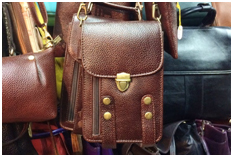 Yashwant
Place Market is located in the diplomatic enclave and is a hot spot amongst
locals and tourists alike. The market is known for leather goods, fancy jewellery
and fur coats to Chinese food is worth exploring. Most of the shopkeepers export
leather products to European countries. The variety of hats, skirts, jackets, gloves,
bags is massive. An ideal market for classic plain leather jackets, Biker jackets,
embellished leather jackets, leather trench coats, real fur coats in every imaginable
length. Leather Totes, satchels, laptop bags, cross-body bags, are also in abundance.
Chinese eating joints, Restaurants, Barbeques would be the place to satiate taste
buds too.
Yashwant
Place Market is located in the diplomatic enclave and is a hot spot amongst
locals and tourists alike. The market is known for leather goods, fancy jewellery
and fur coats to Chinese food is worth exploring. Most of the shopkeepers export
leather products to European countries. The variety of hats, skirts, jackets, gloves,
bags is massive. An ideal market for classic plain leather jackets, Biker jackets,
embellished leather jackets, leather trench coats, real fur coats in every imaginable
length. Leather Totes, satchels, laptop bags, cross-body bags, are also in abundance.
Chinese eating joints, Restaurants, Barbeques would be the place to satiate taste
buds too.
 Lajpat Nagar Central Market is known for its reasonably priced goods, Henna
Appliers and delicious momos. This market houses a blend of branded showrooms, exclusive
garment shops as well as roadside kiosks. It is an ideal shopping destination for
budget travelers. This is the market place for clothes, ethnic wear, designer wear,
western wear, fashionable garments and accessories to footwear, bags, accessories
and other products whereas the Road side kiosks retail affordable garments and items.
This market is closed on every Monday of the week.
Lajpat Nagar Central Market is known for its reasonably priced goods, Henna
Appliers and delicious momos. This market houses a blend of branded showrooms, exclusive
garment shops as well as roadside kiosks. It is an ideal shopping destination for
budget travelers. This is the market place for clothes, ethnic wear, designer wear,
western wear, fashionable garments and accessories to footwear, bags, accessories
and other products whereas the Road side kiosks retail affordable garments and items.
This market is closed on every Monday of the week.
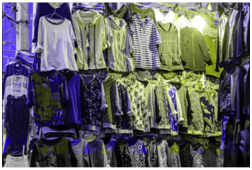 Sarojini
Nagar is one of the places in South West of the city to buy clothes and
fabrics. Apart from a large number of large sized showrooms for various international
and local brands, the crux of the market is formed by street side shops which sell
garments of all sizes, designs and colors. you get fashionable Export-surplus garments
at affordable prices. This market is closed on every Monday of the week.
Sarojini
Nagar is one of the places in South West of the city to buy clothes and
fabrics. Apart from a large number of large sized showrooms for various international
and local brands, the crux of the market is formed by street side shops which sell
garments of all sizes, designs and colors. you get fashionable Export-surplus garments
at affordable prices. This market is closed on every Monday of the week.
 Select CITYWALK, located at Saket District Centre in South Delhi, is spread
out over 6 lakh sq. ft. of retail space and is home to more than 175 brands. It
offers the widest range of labels, numerous carts and kiosks to pick up fun, exciting
products spread across the centre! The mall is home to coveted international beauty
brands, absolutely-must-have clothing labels, a selection of restaurants serving
delicious food and much more. In addition to being the city’s favourite destination
to catch up with friends and a place to relax for the family,it is also a paradise
for every shopaholic.
Select CITYWALK, located at Saket District Centre in South Delhi, is spread
out over 6 lakh sq. ft. of retail space and is home to more than 175 brands. It
offers the widest range of labels, numerous carts and kiosks to pick up fun, exciting
products spread across the centre! The mall is home to coveted international beauty
brands, absolutely-must-have clothing labels, a selection of restaurants serving
delicious food and much more. In addition to being the city’s favourite destination
to catch up with friends and a place to relax for the family,it is also a paradise
for every shopaholic.
 DLF
Promenade Thoughtfully conceived it is one of the Delhi’s premier architectural
and commercial landmarks, creating an environment of great ambience and high energy.
Spread over a total area of 450,000 square feet, ---- three floors -- the ground
and upper ground floor for retail and the first floor entirely dedicated to entertainment.
The multiplex with 7 screens is the largest cinema complex in Delhi and surrounding
areas. This mall is situated at Nelson Mandela Marg Vasant Kunj, New Delhi.
DLF
Promenade Thoughtfully conceived it is one of the Delhi’s premier architectural
and commercial landmarks, creating an environment of great ambience and high energy.
Spread over a total area of 450,000 square feet, ---- three floors -- the ground
and upper ground floor for retail and the first floor entirely dedicated to entertainment.
The multiplex with 7 screens is the largest cinema complex in Delhi and surrounding
areas. This mall is situated at Nelson Mandela Marg Vasant Kunj, New Delhi.
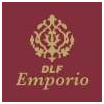 DLF Emporio is India's Most Luxurious Shopping Destination. An unprecedented
collection of the finest and rarest in life, the mall offers a shopping experience
like no other. Four levels of exclusive shopping and dining in an atmosphere of
extraordinary sophistication and refinement are all under one elegant roof. The
cutting edge of the latest fashion trends from the most glamorous International
and Indian design houses are elegantly located here. The world's most desirable
jewelers and watchmakers showrooms are a must to visit. This mall is also situated
at Nelson Mandela Marg Vasant Kunj, New Delhi
DLF Emporio is India's Most Luxurious Shopping Destination. An unprecedented
collection of the finest and rarest in life, the mall offers a shopping experience
like no other. Four levels of exclusive shopping and dining in an atmosphere of
extraordinary sophistication and refinement are all under one elegant roof. The
cutting edge of the latest fashion trends from the most glamorous International
and Indian design houses are elegantly located here. The world's most desirable
jewelers and watchmakers showrooms are a must to visit. This mall is also situated
at Nelson Mandela Marg Vasant Kunj, New Delhi
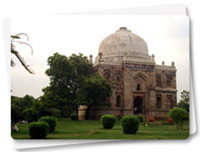 Lodhi
Gardens is a city park of over 90 acres situated in South Central Delhi
and is a hotspot for morning walks for the Delhiites. It is also a popular picnic
spot for the residents. The gardens are dotted with many tombs, of well known rulers
of Delhi, mosques, bridges and watercourses. The garden is also an important place
of preservation. Entry to General Public is free and the park is open from Dawn
to dusk.
Lodhi
Gardens is a city park of over 90 acres situated in South Central Delhi
and is a hotspot for morning walks for the Delhiites. It is also a popular picnic
spot for the residents. The gardens are dotted with many tombs, of well known rulers
of Delhi, mosques, bridges and watercourses. The garden is also an important place
of preservation. Entry to General Public is free and the park is open from Dawn
to dusk.
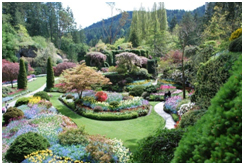 Garden of Five Senses spanning 20 acres is located in southern part of Delhi
around 2 kms from Qutub Minar. The garden is an amalgamation of colour, fragrance,
texture and form with a unique chime of 500 bells producing soothing sounds in its
background. An expansive plaza is set on a natural slope with a troupe of elephants
cut in stone. The garden appeals to all the five senses viz. hear, taste, vision,
touch and smell. Food and shopping courts sell natural and crafts products and refreshments.
Solar Energy Park, with exhibits of solar powered buses, cars and bicycles etc.,
are an attraction for all the visitors to this place. The gardens hosts cultural
programmes like Garden Festival, Yoga Camps, Nature Walks etc.
Garden of Five Senses spanning 20 acres is located in southern part of Delhi
around 2 kms from Qutub Minar. The garden is an amalgamation of colour, fragrance,
texture and form with a unique chime of 500 bells producing soothing sounds in its
background. An expansive plaza is set on a natural slope with a troupe of elephants
cut in stone. The garden appeals to all the five senses viz. hear, taste, vision,
touch and smell. Food and shopping courts sell natural and crafts products and refreshments.
Solar Energy Park, with exhibits of solar powered buses, cars and bicycles etc.,
are an attraction for all the visitors to this place. The gardens hosts cultural
programmes like Garden Festival, Yoga Camps, Nature Walks etc.